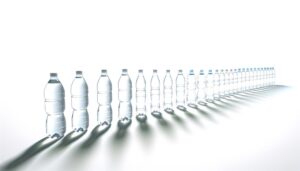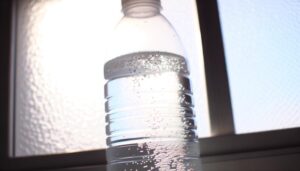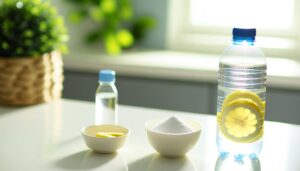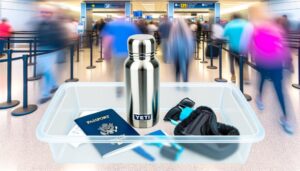Canteen Vs Water Bottle: Which One Better?
Choosing between a canteen and a water bottle depends on your specific needs. Canteens, often made from stainless steel, offer superior insulation and durability, making them ideal for outdoor adventures. They’re heavier but easier to clean due to their wide mouths.
On the other hand, water bottles, typically crafted from lightweight plastic or metal, are more portable and come in a wider range of sizes and designs, suited for everyday use.
While canteens have a lower environmental impact, water bottles add convenience. To make an informed choice, consider how you’ll use them and learn the nuances of each option.
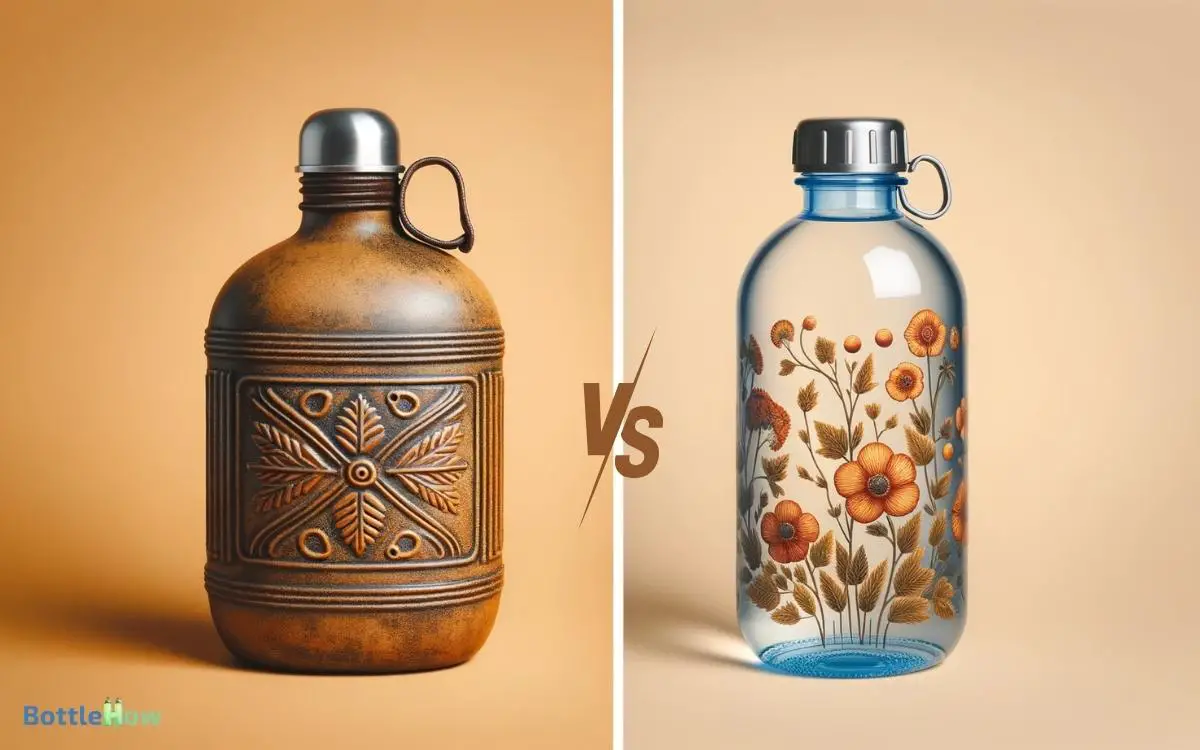
Comparison Between Canteen and Water Bottle
| Feature | Canteen | Water Bottle |
|---|---|---|
| Material | Typically stainless steel, plastic, or aluminum | Mostly plastic, stainless steel, or glass |
| Capacity | Usually larger, ranging from 500ml to 1L+ | Varied, commonly 300ml to 1L |
| Insulation | May have double-wall insulation for temperature retention | Single-wall construction, some offer insulation |
| Portability | Bulkier, may come with a carrying strap or handle | Generally more compact, easier to carry |
| Durability | Often more durable, less prone to denting or breaking | Can be prone to damage, especially if made of thin plastic |
| Eco-friendliness | Depends on material; stainless steel and aluminum are more sustainable than single-use plastics | Focus shifting towards reusable options, but some still contribute to plastic waste |
| Cleaning | Can be harder to clean due to wider mouths and internal threads | Typically easier to clean with wide mouths and simple designs |
| Cost | Usually more expensive upfront, but cost-effective in the long run | Generally cheaper upfront, but frequent replacements can add up over time |
Key Takeaways
Material and Durability
When evaluating canteens and water bottles, you’ll find that the materials used—ranging from stainless steel and aluminum to BPA-free plastics—play a critical role in their overall durability.
Stainless steel canteens offer excellent longevity and resistance to rust, making them ideal for long-term use.
Aluminum, while lightweight and durable, may require a protective lining to prevent contamination.
BPA-free plastics, though lighter and often more affordable, can be prone to wear and tear faster than metals.
The choice of material directly impacts not only the lifespan but also the safety of your hydration container.
You’ll want to assess how each material aligns with your specific needs, whether it’s for rugged outdoor adventures or everyday urban use.
Weight and Portability
Considering the durability of materials is essential, but weight and portability are equally important factors when choosing between a canteen and a water bottle.
Let’s break it down:
- Weight: Canteens are often heavier due to thicker materials, while water bottles, especially those made from modern plastics or lightweight metals, are lighter.
- Portability: Water bottles usually have ergonomic designs that fit into bags or car holders. Canteens might come with straps but can be bulkier.
- Ease of Carry: Water bottles typically feature handles or loops for easy attachment to bags. Canteens may require additional carrying gear.
- Capacity: Water bottles come in various sizes, making them versatile for different needs. Canteens often have fixed capacities, limiting flexibility.
Choose based on your specific activity and convenience.
Insulation Capabilities
When comparing canteens and water bottles, you’ll find that their insulation capabilities greatly affect temperature retention.
Materials like stainless steel in canteens often provide superior insulation compared to plastic water bottles.
Consider how these material differences influence your choice based on whether you need to keep liquids hot or cold for extended periods. For example, when comparing heat pad vs hot water bottle, a heat pad may provide more consistent warmth over time, while a hot water bottle gradually loses heat. Additionally, the material and insulation properties of each option determine how long they retain their temperature, making one more suitable than the other depending on your needs. Considering these factors will help you make a more informed decision based on duration and effectiveness.
Temperature Retention Comparison
Evaluating the temperature retention of canteens versus water bottles reveals significant differences in their insulation capabilities, directly impacting how long they keep your beverages hot or cold.
When you need reliable temperature retention, consider these points:
- Double-Walled Vacuum Insulation: Canteens often feature superior vacuum insulation, maintaining temperature for up to 24 hours.
- Single-Walled Water Bottles: Many water bottles lack the double-walled construction, resulting in quicker temperature loss.
- Material Thickness: Thicker-walled canteens generally provide better insulation compared to thinner-walled water bottles.
- Seal Quality: Canteens usually come with high-quality seals, preventing heat exchange more effectively than standard water bottle caps.
Material Impact Analysis
The choice of materials greatly influences the insulation capabilities of canteens and water bottles.
Metal and double-walled designs outperform plastic and single-walled variants. If you’re seeking top temperature retention, stainless steel canteens with vacuum insulation are your best bet.
They keep your drinks hot or cold for hours, thanks to the vacuum layer that minimizes thermal exchange.
In contrast, plastic water bottles, especially single-walled ones, offer poor insulation, causing rapid temperature loss.
Aluminum bottles, while lightweight, also underperform compared to double-walled stainless steel models.
Not only do these materials affect thermal retention, but they also impact durability and user experience.
Choose wisely to guarantee your drink stays invigorating, whether you’re hiking with friends or working in an office setting.
Ease of Cleaning
Given their typically wider mouths, canteens are often easier to clean thoroughly compared to water bottles.
This makes them a practical choice for those who prioritize hygiene. You’ll find that scrubbing the interior of a canteen is straightforward, especially if you’re using a sponge or brush.
On the other hand, water bottles often have narrow necks, making them more challenging to clean.
Here are some points to keep in mind:
- Access: Canteens provide better access for cleaning tools.
- Residue: Less likely to have residue buildup in canteens.
- Tool Compatibility: Canteens work well with standard kitchen brushes.
- Sanitization: Easier to guarantee complete sanitization in canteens.
Environmental Impact
Considering their construction and lifespan, canteens often have a lower environmental impact compared to disposable plastic water bottles.
You’ll find that stainless steel or aluminum canteens are designed for repeated use, reducing the need for constant replacements. In contrast, plastic bottles contribute considerably to landfill waste and ocean pollution.
| Aspect | Canteens | Disposable Plastic Bottles |
|---|---|---|
| Lifespan | Long-term | Single-use |
| Material | Stainless steel, aluminum | PET plastic |
| Recyclability | High, if properly recycled | Low, often not recycled correctly |
Cost Comparison
When comparing the cost of a canteen and a water bottle, you should consider the initial purchase price, long-term investment, and replacement frequency.
While canteens often come with a higher upfront cost, their durability can make them a better long-term investment.
On the other hand, water bottles might be cheaper initially but could require more frequent replacements, adding to the overall expense.
Initial Purchase Price
The initial purchase price of a canteen can often be higher than that of a standard water bottle, but the materials and durability of canteens usually justify the cost.
When comparing the two, consider the following:
- Material Quality: Canteens are often made from stainless steel or high-grade plastic, whereas regular water bottles use cheaper plastics.
- Durability: Canteens are designed to withstand harsh conditions, making them a reliable choice for outdoor enthusiasts.
- Insulation: Many canteens offer superior insulation, keeping your drinks hot or cold for longer periods.
- Design Features: Canteens often come with additional features like integrated cups or multi-functional lids.
Long-Term Investment
Investing in a canteen often proves more economical over time due to its superior durability and reduced need for frequent replacements compared to standard water bottles.
Canteens, typically made from robust materials like stainless steel, withstand daily wear and tear better than plastic water bottles.
You’ll find the initial higher cost of a canteen is offset by its longevity, making it a prudent choice for the long haul.
Here’s a cost comparison to illustrate:
| Item | Initial Cost | Lifespan | Annual Replacement Cost |
|---|---|---|---|
| Canteen | $25 | 5 years | $5 |
| Water Bottle | $10 | 1 year | $10 |
Replacement Frequency
How often do you find yourself needing to replace your water bottle compared to a canteen? Water bottles, especially plastic ones, tend to wear out faster.
Here’s a comparative breakdown:
- Plastic Water Bottles: Typically last 6-12 months due to wear and tear.
- Stainless Steel Water Bottles: Generally last 1-3 years but can dent easily.
- Aluminum Canteens: Often last 3-5 years, offering a longer lifespan.
- Stainless Steel Canteens: Can last up to a decade with proper care.
Considering these factors, canteens have a lower replacement frequency, which translates to long-term cost savings.
Versatility
Canteens offer a rugged durability suited for outdoor adventures, while water bottles provide a lightweight convenience ideal for everyday use.
If you’re hitting the trails, canteens can withstand rough handling and temperature extremes, making them perfect for hiking, camping, or military use. They often include features like insulation, which keeps your drink at a stable temperature longer.
On the other hand, water bottles excel in urban environments. Their lightweight design makes them easy to carry in your bag, and they fit comfortably in car cup holders and gym equipment.
Modern water bottles come with user-friendly attributes like easy-open caps and ergonomic grips.
Versatility depends on your lifestyle: choose a canteen for durability in rugged conditions or a water bottle for daily, hassle-free hydration.
Style and Design
When it comes to style and design, water bottles often boast sleek, modern aesthetics, while canteens retain a more traditional, utilitarian look.
You’ll find water bottles appealing if you prioritize contemporary designs and lightweight materials.
They often feature:
- Ergonomic shapes for easy handling.
- Varied colors and patterns to match personal style.
- Innovative caps and lids for convenient access.
- Transparent or semi-transparent bodies for easy content visibility.
Canteens, on the other hand, are designed for rugged durability and practical use. They typically lack the variety seen in water bottles but offer robustness that appeals to outdoor enthusiasts. If you value a classic look with functional reliability, a canteen might be your ideal choice.
Capacity Options
When considering capacity options, you’ll find that canteens and water bottles offer distinct advantages.
Canteens typically come in larger sizes, making them ideal for extended trips where you need more hydration.
On the other hand, water bottles provide a wider range of volume variability, catering to different usage scenarios from daily commutes to intense workouts.
Volume Variability
Understanding the volume variability of canteens and water bottles is essential for selecting the right capacity to meet your hydration needs.
Canteens typically offer a range of capacities but are often more limited compared to water bottles.
Here’s a detailed comparison to help you decide:
Canteens:
- Commonly available in 1 to 2 liters.
- Suitable for extended outdoor activities.
- Often bulkier due to their construction materials.
Water Bottles:
- Vary widely from 500 milliliters to 3 liters.
- Ideal for both urban and outdoor use.
- More options for compact, lightweight designs.
Size Choices
Moving from volume variability to size choices, selecting the right capacity for your canteen or water bottle involves weighing your specific hydration needs against the available options.
Think about how long you’ll be out and how much water you typically consume. Here’s a comparison to help you choose:
| Capacity | Ideal For |
|---|---|
| 500ml (16oz) | Short outings, minimal use |
| 750ml (25oz) | Moderate exercise, daily use |
| 1L (32oz) | Day hikes, active users |
| 1.5L (50oz) | Long hikes, extended trips |
| 2L (68oz) | All-day activities, multi-day trips |
Opt for smaller sizes for light activities and larger ones for prolonged endeavors. Matching your canteen or water bottle to your activity level ensures you stay hydrated without extra bulk.
Usage Scenarios
Selecting the appropriate canteen or water bottle capacity involves evaluating various usage scenarios to guarantee ideal hydration and convenience.
When you’re deciding, consider these common situations:
- Daily Commutes: Opt for a 500ml to 750ml bottle. It’s compact and fits in most bags, ensuring you stay hydrated without extra bulk.
- Outdoor Activities: For hiking or camping, a 1-2 liter canteen is essential. It provides enough water for extended periods while maintaining portability.
- Workouts: A 750ml to 1-liter bottle balances capacity and ease of use, perfect for gym sessions or long runs.
- Traveling: A larger 3-5 liter canteen is ideal for road trips or flights, offering ample hydration without frequent refills.
User Experience
When evaluating user experience, a canteen’s rugged design often provides durability and insulation, while a water bottle’s lightweight construction offers convenience and portability.
You’ll appreciate a canteen if you need a sturdy container that maintains temperature, ideal for long journeys. However, its bulkiness might be cumbersome for quick trips.
Water bottles, in contrast, are easier to carry and fit neatly into bags or cup holders, perfect for daily commutes or gym sessions.
Consider the canteen’s wide mouth, making it easier to clean and fill, versus some water bottles’ narrow openings, which may limit ease of use.
Ultimately, your choice hinges on whether you prioritize robust durability or streamlined convenience, catering to your specific needs and lifestyle.
Best for Activities
For outdoor adventures like hiking or camping, a canteen’s robust build and insulation excel, whereas a water bottle’s lightweight design and portability shine during gym sessions or daily commutes.
You’ll appreciate a canteen’s ability to keep liquids at a steady temperature for extended periods, making it ideal for long treks.
On the other hand, water bottles are easier to carry and fit conveniently into backpacks or cup holders.
Here’s a quick comparison to help you decide:
- Hiking/Camping: Canteen’s durability and insulation.
- Gym Sessions: Water bottle’s lightweight and ease of use.
- Daily Commute: Water bottle’s portability and quick access.
- Extreme Conditions: Canteen’s resilience and temperature control.
Choose based on your activity to get the best experience.
Conclusion
Choosing between a canteen and a water bottle is like selecting the right tool for a journey. The canteen, rugged and enduring, stands ready for rough terrains. The water bottle, sleek and lightweight, suits fast-paced adventures.
Each has its merits: insulation, ease of cleaning, environmental impact, and style. Understand your needs, and you’ll find your perfect companion.
Remember, making the right choice guarantees your hydration stays as dependable as your spirit of exploration.


